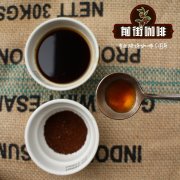Coffee knowledge sharing: main ingredients and aroma sources of coffee beans

Professional coffee knowledge exchange more coffee bean information please follow the coffee workshop (Wechat official account cafe_style)
The main components of coffee beans
Sucrose: in the process of baking, part of the sucrose will be decomposed into acetic acid, formic acid, glycolic acid, lactic acid, the other part of the sucrose will go through the caramelization reaction to form caramel, increasing the flavor of coffee.
Caffeine: it tastes bitter and has a high melting point of 237 ℃, so caffeine is almost preserved in roasted coffee beans. Caffeine has a diuretic effect and helps to expel excess sodium ions from the body.
Chlorogenic acid: chlorogenic acid in coffee helps to stop weight gain, about 50% of chlorogenic acid will be reduced to quinic acid.
Quinic acid: the amount of quinic acid with the degradation of chlorogenic acid, after the second explosion, the content reached the peak.
Acidic fat: there is acid in fat, although the degree varies according to the type of fat.
Volatile fat: the aroma of coffee.
Protein: is the source of calories.
Fiber: raw coffee beans are carbonized after roasting and combine with caramel to form the hue of coffee.
Minerals: there are a small amount of iron, lime, phosphorus, sodium carbonate.
The source of aroma of coffee
For bleaching wood acid, caffeine alcohol, bleached wood acid slightly sour taste, and coffee alcohol slightly roasted from breaking, so raw coffee beans do not have this flavor, if the coffee beans boil too long, the coffee alcohol will volatilize, leaving only tannins, will form bitter coffee. Coffee itself does not have much nutrition, most of the nutrition is to add sucrose and milk, but there is a kind of fenuanetine in coffee, which can be converted into nicotinic acid when roasting coffee beans.
Nicotinic acid is vitamin B3, which helps calm nerves and soothes the mood, and is also good for the intestines, stomach and skin, but it is also easy to cause rough cutin and dry black spots. In 1926, Furfuryl mercaptanz-fuyul-methanethiol was identified as an important aroma compound in coffee roasting. The aroma components contained in coffee beans, such as carbohydrates, amino acids, lipids, etc., can be said to be an important factor in considering the quality of coffee raw materials. Whether the processing conditions are appropriate or not has a decisive impact on the aroma. The volatile substances in coffee are the main source of coffee aroma, and the existing conditions affect the aroma of coffee. This volatile substance is not volatile in raw coffee beans and needs to be roasted before it is produced.
End
Important Notice :
前街咖啡 FrontStreet Coffee has moved to new addredd:
FrontStreet Coffee Address: 315,Donghua East Road,GuangZhou
Tel:020 38364473
- Prev

A brief introduction to the origin and planting environment of Kona, a boutique coffee bean from Hawaii
Professional coffee knowledge exchange more coffee bean information please follow the coffee workshop (Wechat official account cafe_style) Kona coffee beans are produced in the Kona area of Hawaii, this kind of coffee beans can only be grown on volcanic slopes and belong to a rare species. In addition to its beautiful scenery, Hawaii, a beautiful tropical Pacific island, also produces the famous Kona coffee. Kona coffee is made from
- Next

Coffee knowledge sharing: you like coffee, but is drinking coffee harmful to your health for a long time?
Professional coffee knowledge exchange more coffee bean information please pay attention to the coffee workshop (Wechat official account cafe_style) the impact of regular coffee: it is common to see the symptoms of insomnia and anxiety caused by caffeine, caffeine used more than 500mg a day, it will make people anxious, irritable, restless, etc.; if the daily consumption is more than one gram, there may be thinking, loose speech and heart.
Related
- Beginners will see the "Coffee pull flower" guide!
- What is the difference between ice blog purified milk and ordinary milk coffee?
- Why is the Philippines the largest producer of crops in Liberia?
- For coffee extraction, should the fine powder be retained?
- How does extracted espresso fill pressed powder? How much strength does it take to press the powder?
- How to make jasmine cold extract coffee? Is the jasmine + latte good?
- Will this little toy really make the coffee taste better? How does Lily Drip affect coffee extraction?
- Will the action of slapping the filter cup also affect coffee extraction?
- What's the difference between powder-to-water ratio and powder-to-liquid ratio?
- What is the Ethiopian local species? What does it have to do with Heirloom native species?

